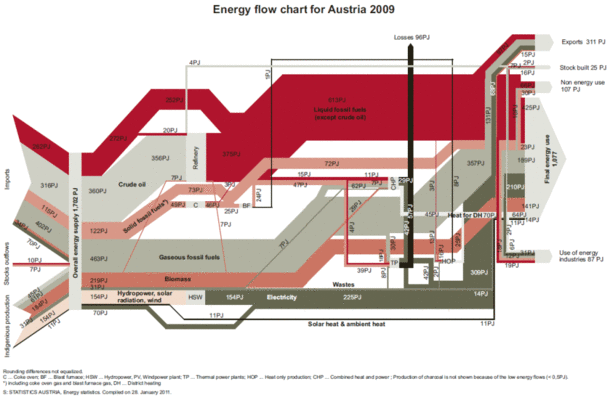Knowledge fuels change - Support energypedia!
For over 10 years, energypedia has been connecting energy experts around the world — helping them share knowledge, learn from each other, and accelerate the global energy transition.
Today, we ask for your support to keep this platform free and accessible to all.
Even a small contribution makes a big difference! If just 10–20% of our 60,000+ monthly visitors donated the equivalent of a cup of coffee — €5 — Energypedia would be fully funded for a whole year.
Is the knowledge you’ve gained through Energypedia this year worth €5 or more?
Your donation keeps the platform running, helps us create new knowledge products, and contributes directly to achieving SDG 7.
Thank you for your support, your donation, big or small, truly matters!
Difference between revisions of "Austria Energy Situation"
***** (***** | *****) m |
***** (***** | *****) m |
||
| Line 119: | Line 119: | ||
*[http://www.bmwfj.gv.at/Seiten/default.aspx Austrian Federal Ministry for Economy, Families and Youth] | *[http://www.bmwfj.gv.at/Seiten/default.aspx Austrian Federal Ministry for Economy, Families and Youth] | ||
*[http://www.bmvit.gv.at/ Austrian Federal Ministry for Transport, Innovation and Technology] | *[http://www.bmvit.gv.at/ Austrian Federal Ministry for Transport, Innovation and Technology] | ||
| + | *[[Fuel_Price_Data_Austria|Fuel Price Data Austria]]<br/> | ||
<br/> | <br/> | ||
| Line 126: | Line 127: | ||
<references /> | <references /> | ||
| + | [[Category:Country_Energy_Situation]] | ||
[[Category:Austria]] | [[Category:Austria]] | ||
| − | |||
Revision as of 11:46, 16 July 2014
| Republic of Austria | |||
|---|---|---|---|
| Capital | Vienna(48°12′N 16°21′E) | ||
| Official Languages(s) | German | ||
| Government | Federal Parliamentary republic | ||
| President | Heinz Fischer | ||
| Chancellor | Werner Faymann (SPÖ) | ||
| Total Area | 83,855 km² | ||
| Population | 8,414,638 (2011 estimate) | ||
| GDP (Nominal) | $405 billion | ||
| GDP Per Capita | $48,350 | ||
| Currency | Euro (EUR) | ||
| Time Zone | CET (UTC+01) | ||
| Electricity Generation | TWh/year (year) | ||
| Calling Code | +43 | ||
| Access to Electricity % | |||
| Wind energy (installed capacity) | MW (year) | ||
| Solar Energy (installed capacity) | MW (year) | ||
Overview
Energy Efficiency
- see report by the Austrian Energy Agency on Energy Efficiency Policies and Measures in Austria (2009)
Policy Framework, Laws, Regulations - Recent Developments
Energy Strategy[1]
In 2010, the two ministries (economy and environment) presented, after a lenghty stekeholder process, the Strategy Austria (engl Kurzfassung) (2).pdf Austria Energy Strategy (2010), which is founded on three principles:
- Security of energy supply
- Energy efficiency
- Renewable energies
On the basis of these principles, Austria’s energy strategy is primarily directed at enhancing energy efficiency at every level where energy is supplied and consumed. Furthermore, it is necessary to improve security of supply and crisis provision for every source of energy and to strive to achieve as high a degree of energy autonomy as possible, while at the same time taking into account cost efficiency.
-> also see IEA (2007) report: Energy Policies of IEA Countries - Austria Review 2007
Renewable Energiy Mandate[2]
Mandatory targets set by the Directive on the Promotion of the use of energy from renewable sources:
- 34 % share of RES on the gross final energy consumption of energy in 2020.
- At least 10% share of renewable energy in final consumption of energy in transport by 2020.
Indicative Target set by the RES- electricity European Directive from 20015:
- 78.1 % share of RES on gross electricity consumption by 2010.
Indicative Target set by the European Biofuels Directive from 2003:
- Biofuels consumption of 5.75% of final energy consumption of petrol and diesel use for transport in 2010.
Legal Framework on the Promotion of renewable energies in Austria:
- Green electricity Act
- Subsidy Directive
- Green Electricity Regulation 2011
Further Information
- Statistics on energy by Statistik Austria
- Austrian Energy Agency
- Austrian Federal Ministry for Environment
- Austrian Federal Ministry for Economy, Families and Youth
- Austrian Federal Ministry for Transport, Innovation and Technology
- Fuel Price Data Austria




















